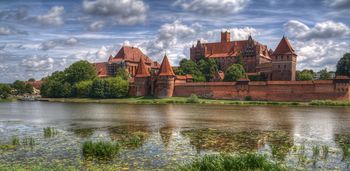Malbork Castle

Malbork Castle was built from brick because suitable building stone was not available nearby.
Malbork Castle in Poland was founded in the 13th century by the Order of Teutonic Knights.[1] From 1309 it was the headquarters of the Order. Occupying an area of 52 acres it is the largest brick-built castle in the world. Called Marienburg in the German language, the castle was named after the Virgin Mary.
History
The Order of the Teutonic Knights was by German knights who accompanied Frederick Barbarossa on the Third Crusade. The army disbanded after Barbarossa drowned. The Order was given papal recognition by Innocent III in 1199.[2] Though founded to protect Christians in the Near East, the Order turned its attention to eastern Europe and in 1226 attacked the pagan Prussians of eastern Europe near the Baltic Sea. The intention was to convert the Prussians to Christianity and protect the lands of the Christian Polish princes. In 1283 the Kingdom of the Teutonic Knights was inaugurated.[3] Construction of Malbork Castle began in 1272. Emphasising the religious aspect of the castle's owners, it was named the Marienburg after the Virgin Mary. Many castles built by the Teutonic Knights were named after her.[4]
The fall of Acre in 1291 meant that the Teutonic Knights no longer had to defend the Holy Land, so could concentrate their resources on. When it became clear that the church would not call a crusade to recover the Holy Land, the order's headquarters were moved from Venice (which would have been the disembarkation point for travel to the Near East) and established at Malbork in September 1309. At the time there were suggestions that all military orders should be dissolved. King Philip IV of France was a particularly strong proponent of this view and persecuted the Knights Templar within France. Malbork was chosen as the headquarters of the Teutonic Knights partly because it was beyond Philip's reach.[5]
In 1997 Malbork Castle was designated a World Heritage Site by UNESCO, recognising the importance of the site. It is named the "Castle of the Teutonic Order in Malbork".[6]
Layout and architecture
Malbork Castle is mainly built from red brick. This was the case for many castles along the coast of the Baltic Sea as the region was poor in stone suitable for construction. Covering an area of 52 acres Malbork is the largest brick-built castle in the world.[7] The castle is divided into three enclosures: the Outer Castle, the Middle Castle, and the Upper Castle.[8]
References
- ↑ Emery, Anthony (2007). "Malbork Castle – Poland", The Castle Studies Group Journal 21. p. 139.
- ↑ Sterns, Indrikis (1985). "The Teutonic Knights in the Crusader States" in Kenneth Meyer Setton, Norman P. Zacour, and Harry W. Hazard (eds.), A History of the Crusades, Volume V: The Impact of the Crusades on the Near East. pp.–317. University of Wisconsin Press. ISBN 0-299-09140-6.
- ↑ Emery, "Malbork Castle – Poland", pp. 141–142.
- ↑ Christiansen, Eric (1997). The Northern Crusades, 2nd edition. London: Penguin Books. pp. 222. ISBN 978-0140266535.
- ↑ Christiansen, The Northern Crusades, pp. 150–151.
- ↑ Castle of the Teutonic Order in Malbork, UNESCO, accessed 28 February 2013.
- ↑ Emery, "Malbork Castle – Poland", p. 143.
- ↑ Emery, "Malbork Castle – Poland", p. 140.